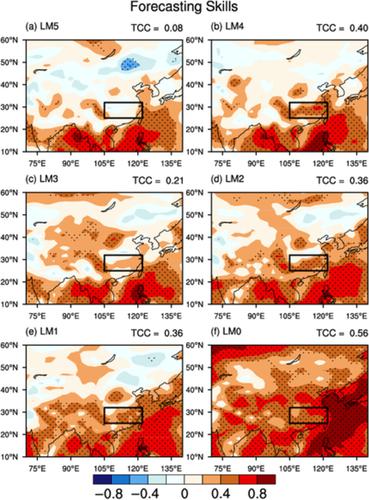当前位置:
X-MOL 学术
›
Int. J. Climatol.
›
论文详情
Our official English website, www.x-mol.net, welcomes your
feedback! (Note: you will need to create a separate account there.)
Predictability of the mid‐summer surface air temperature over the Yangtze River valley in the National Centers for Environmental Prediction Climate Forecast System
International Journal of Climatology ( IF 3.5 ) Pub Date : 2020-05-18 , DOI: 10.1002/joc.6670 Shankai Tang 1 , Shaobo Qiao 1, 2, 3 , Taichen Feng 1 , Zikang Jia 1 , Naihui Zang 1 , Guolin Feng 1, 3, 4, 5
International Journal of Climatology ( IF 3.5 ) Pub Date : 2020-05-18 , DOI: 10.1002/joc.6670 Shankai Tang 1 , Shaobo Qiao 1, 2, 3 , Taichen Feng 1 , Zikang Jia 1 , Naihui Zang 1 , Guolin Feng 1, 3, 4, 5
Affiliation

|
By using the hindcast and forecast data from the National Centers for Environmental Prediction Climate Forecast System version 2 (NCEP CFSv2) for the 1982–2018 period, we investigate the forecasting skills of the mid‐summer (July and August) surface air temperature (SAT) at interannual timescales in this study. Although CFSv2 predictions show a warm bias for the climatological mean SAT over the Yangtze River valley (25°–32°N, 105°–122°E), they show a consistent and great performance in predicting the interannual variability of the mid‐summer SAT over this region until 4 months in advance, where the linear correlation coefficient between the predicted and observed time series reaches +0.65, +0.51 and + 0.68 for 4, 2 and 0 months in advance, respectively. The CFSv2 predictions well simulate the linkage between the SAT anomalies over the Yangtze River valley and the anomalous atmospheric circulation aloft, including the circumglobal teleconnection and zonal extension of the Western Pacific Subtropical High. However, CFSv2 has trouble in simulating the associated vertical velocity, cloud cover and solar radiation anomalies, except for 0 months in advance. The persistent forecasting skills result from the accurate response of the circumglobal teleconnection and Western Pacific Subtropical High to the El Niño/Southern Oscillation and sea surface temperature (SST) anomalies over the mid‐latitude North Atlantic. Correspondingly, the forecasting skill, signal and signal‐to‐noise ratio are effectively improved in the years with strong mid‐summer SST anomalies over the tropical central‐eastern Pacific or mid‐latitude North Atlantic. These results are useful for understanding the predictability of the mid‐summer SAT over the Yangtze River valley.
中文翻译:

国家环境预测气候预报系统中长江流域仲夏地表气温的可预测性
通过使用国家环境预测气候预报系统版本2(NCEP CFSv2)的1982-2018年期间的后预报和预报数据,我们研究了仲夏(7月和8月)地面气温(SAT)的预报技巧)在本研究中以每年的时间尺度进行。尽管CFSv2的预测显示长江流域(25°–32°N,105°–122°E)的气候平均SAT有一个温暖的偏差,但它们在预测仲夏的年际变化方面显示出一致且出色的性能该区域的SAT提前4个月,其中预测和观察到的时间序列之间的线性相关系数分别提前4、2和0个月达到+ 0.65,+ 0.51和+ 0.68。CFSv2的预测很好地模拟了长江流域的SAT异常与高空大气环流之间的联系,包括环全球遥相关和西太平洋副热带高压的纬向扩展。但是,CFSv2很难模拟相关的垂直速度,云量和太阳辐射异常,除非提前0个月。持续的预报技能来自周围全球遥相关和西太平洋副热带高压对北大西洋中纬度地区的厄尔尼诺/南方涛动和海表温度(SST)异常的准确响应。相应地,预测技巧 在热带中东部太平洋或北纬中纬度热带地区夏季强SST异常的年份中,信号和信噪比得到了有效改善。这些结果对于了解长江流域仲夏SAT的可预测性很有用。
更新日期:2020-05-18
中文翻译:

国家环境预测气候预报系统中长江流域仲夏地表气温的可预测性
通过使用国家环境预测气候预报系统版本2(NCEP CFSv2)的1982-2018年期间的后预报和预报数据,我们研究了仲夏(7月和8月)地面气温(SAT)的预报技巧)在本研究中以每年的时间尺度进行。尽管CFSv2的预测显示长江流域(25°–32°N,105°–122°E)的气候平均SAT有一个温暖的偏差,但它们在预测仲夏的年际变化方面显示出一致且出色的性能该区域的SAT提前4个月,其中预测和观察到的时间序列之间的线性相关系数分别提前4、2和0个月达到+ 0.65,+ 0.51和+ 0.68。CFSv2的预测很好地模拟了长江流域的SAT异常与高空大气环流之间的联系,包括环全球遥相关和西太平洋副热带高压的纬向扩展。但是,CFSv2很难模拟相关的垂直速度,云量和太阳辐射异常,除非提前0个月。持续的预报技能来自周围全球遥相关和西太平洋副热带高压对北大西洋中纬度地区的厄尔尼诺/南方涛动和海表温度(SST)异常的准确响应。相应地,预测技巧 在热带中东部太平洋或北纬中纬度热带地区夏季强SST异常的年份中,信号和信噪比得到了有效改善。这些结果对于了解长江流域仲夏SAT的可预测性很有用。











































 京公网安备 11010802027423号
京公网安备 11010802027423号